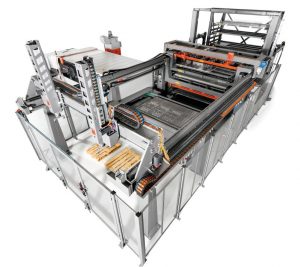 When planning for a Fiber laser cutting system, it becomes critical to look at automating material storage and retrieval systems and material load/unload systems.
When planning for a Fiber laser cutting system, it becomes critical to look at automating material storage and retrieval systems and material load/unload systems.
The raw material must be ready without any delays in presenting it to the laser for processing. In addition, machine automation technologies are critical to a smooth transition between different cut materials. Completing the unload/load cycles in the time while the machine is still processing and eliminating the set-ups in transitioning to different material types and thicknesses is critical to maintaining the advantages gained from high-speed Fiber laser processing.
Material Automation
Maintaining materials at the ready is essential to maintaining a consistent pace of production and reducing non-productive time. How often have you seen a laser cutting machine sitting idle because it doesn’t have the raw material to process the job? Keeping a machine supplied with the proper materials and in a timely manner is a task that requires precision timing. Often, it is the task of a forklift operator or even the machine operator to make sure the laser has the required materials, but timing is everything, and inevitably this leads to inefficiencies and lost production time.
Automating for High-Mix
If you are operating in a high-mix material environment, automating the material storage and handling is essential. Each changeover of material is an opportunity to either maintain your pace of production or add non-productive time. The higher the changeover rate, the higher the risk of production loss due to not having the proper materials supplied to the machine. In addition, machine automation technologies such as automatic nozzle changer, automatic nozzle centering, automatic focal length, and focal point adjustment are critical to eliminating set-up times between different material types and thicknesses.
Automating for Efficiency and Throughput
With a fully automated Fiber laser cutting system, the speed advantages gained from the throughput of the Fiber laser cutting system can be truly realized. As jobs are released to the Fiber laser machine job queue, the material information is simultaneously transmitted to the automated material storage system, in order to retrieve the correct material and present it to the automatic loading system. This is all accomplished while the machine is processing the current job and the part sorting/unloading system stacks the finished cut parts and removes the residual cut sheets.
Automating for the Big Picture
Downstream processes now have the needed parts without experiencing production bottlenecks associated with non-automated Fiber laser cutting systems. Press brakes and welding stations are provided their required cut parts in a timely manner. Overall, the speed from the digital file to the finished product is streamlined, providing for higher efficiency, productivity, revenue, and timely customer deliveries.
The goal of automating is to completely eliminate non-productive waiting and setup times and provide consistency in production planning, efficiency, and throughput. Automated systems can also help your machines run unattended in the off-shifts. This helps justify the investment with additional revenue generated from increased part volumes due to increased machine capacity. Increasing efficiency, throughput, and revenues are just some of the tangible benefits. Customer satisfaction as a result of better deliveries and faster turnaround times also becomes a competitive differentiator.
By Frank Arteaga, Head of Product Marketing, Bystronic Inc., Hoffman Estates, IL
Voice.bystronic@bystronic.com
